Karate, meaning “empty hand” in Japanese, is an unarmed martial arts discipline that originated in Okinawa, Japan, in the 17th century. It was developed by the people of Okinawa as a means of self-defense since they were forbidden to carry weapons. Over time, karate was introduced to mainland Japan and underwent further development. Today, karate is practiced worldwide and has become one of the most popular martial arts.
- Karate originated in Okinawa, Japan, in the 17th century.
- It was developed as a means of self-defense by the people of Okinawa.
- Karate gradually spread to mainland Japan and underwent further development.
- Today, karate is practiced worldwide and is one of the most popular martial arts.
The Evolution of Karate
Karate, an ancient martial arts discipline, has a rich history deeply rooted in the indigenous fighting techniques of the Ryukyu Islands (now Okinawa) and Chinese martial arts. The early forms of karate, known as te, were developed and practiced by the people of Okinawa as effective self-defense techniques. These techniques were shaped by the exchange of knowledge with China, particularly the Fujian province, influencing the development of unarmed combat techniques.
Okinawa’s ban on weapons during certain time periods further contributed to the refinement and evolution of karate as a means of self-defense. With the passing of time, karate traveled from the Ryukyu Islands to mainland Japan in the 20th century. There, it underwent further refinement and codification, leading to the establishment of various styles and systems.
Over the centuries, karate has adapted and absorbed influences from different sources, blending the traditional fighting arts of Okinawa with Chinese martial arts. This fusion has resulted in a unique martial art form that emphasizes striking, kicking, and defensive blocking techniques.
The evolution of karate has transformed it from a local self-defense practice into a globally recognized martial art. Today, karate is practiced by millions of individuals worldwide, transcending cultural boundaries and captivating people with its philosophy, discipline, and physical prowess.
Explore the table below to learn more about the roots, historical origins, and distinctive features of karate:
| Roots | Origins | Distinctive Features |
|---|---|---|
| Ryukyu Islands (Okinawa) | 17th century | Combines indigenous techniques with Chinese martial arts influences |
| China (Fujian province) | Influenced by exchange of knowledge with Okinawa | Emphasis on striking, kicking, and defensive blocking techniques |
| Okinawa | Te (early form of karate) | Developed during periods of weapon bans |
| Mainland Japan | 20th century | Further refinement and codification into various styles and systems |
The Influence of Daruma and Shaolin Temple
The historical background of karate can be traced back to ancient origins that were deeply influenced by Daruma, the founder of Zen Buddhism in Western India. Daruma played a significant role in introducing Buddhism to China and developed a progressive training system to strengthen his disciples physically and mentally. This system was documented in Ekkin-Kyo, the earliest written source on karate. Daruma’s teachings laid the foundation for the physical and philosophical aspects of karate that would emerge later on.
Another influential factor in the development of karate was the physical training taught in the Shaolin Temple. The Shaolin Temple, located in China, emphasized rapid and dynamic movements in its combat practice. These movements were incorporated into the development of karate and shaped its unique style and techniques.
The combination of Daruma’s teachings and the training methods from the Shaolin Temple led to the creation of Okinawa-te, the original fighting method of Okinawa. Okinawa-te later evolved into what is known today as karate.
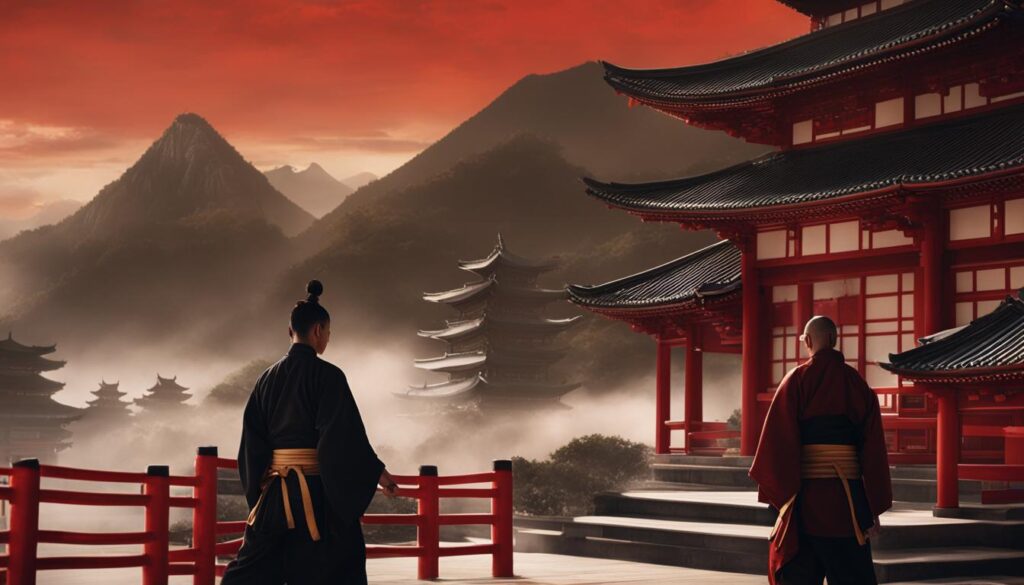
Through the influence of Daruma and the Shaolin Temple, karate gained a solid historical background and acquired techniques that have been passed down through generations. These ancient origins continue to shape the practice and philosophy of karate today.
Master Gichin Funakoshi and the Birth of Shotokan Karate
Gichin Funakoshi, often referred to as the “father of modern Karate-do,” was a key figure in the introduction of karate to mainland Japan. Funakoshi’s mastery of multiple Okinawan karate styles and his ability to synthesize them led to the creation of Shotokan, a comprehensive discipline within karate. In 1916, Funakoshi began teaching karate in Japan, where he showcased the art through captivating demonstrations.
Notably, Funakoshi played a pivotal role in establishing the first university karate club at Keio University, further popularizing and spreading the practice of karate. His teachings and philosophy formed the foundation for the development of many karate styles that exist today. Through his efforts, Funakoshi laid the groundwork for the global recognition and widespread practice of karate as a martial art and a path to personal growth.
Key Facts – Master Gichin Funakoshi and the Birth of Shotokan Karate
| Full Name | Gichin Funakoshi |
|---|---|
| Nicknames/Aliases | “Father of modern Karate-do” |
| Contribution | Introduced karate to mainland Japan and synthesized multiple Okinawan karate styles into the Shotokan discipline |
| Teaching | Began teaching karate in Japan in 1916 and established the first university karate club at Keio University |
| Legacy | Foundation for the development of many karate styles and global recognition of karate as a martial art |
The Spread of Karate Worldwide
Thanks to the relentless efforts of Gichin Funakoshi and other early pioneers, karate gradually transcended national borders and gained recognition and popularity around the world. The post-World War II era marked a significant turning point for karate as Okinawa became a key United States military site, exposing American servicemen to the art. This exposure led to an increased interest in karate among the servicemen stationed in Okinawa, who then spread their newfound passion for the martial art upon returning to their home countries.
The global popularity of karate was further accelerated by the rise of martial arts movies in the 1960s and 1970s that featured iconic figures like Bruce Lee and Jackie Chan. These movies captivated audiences worldwide and generated immense interest in striking-based Asian martial arts, with “karate” becoming a household term among English speakers to refer to various Asian martial arts disciplines.
Today, karate boasts a worldwide following with millions of individuals practicing the art across different continents. The World Karate Federation estimates that there are over 100 million practitioners globally, showcasing the immense reach and popularity of karate as a martial art.
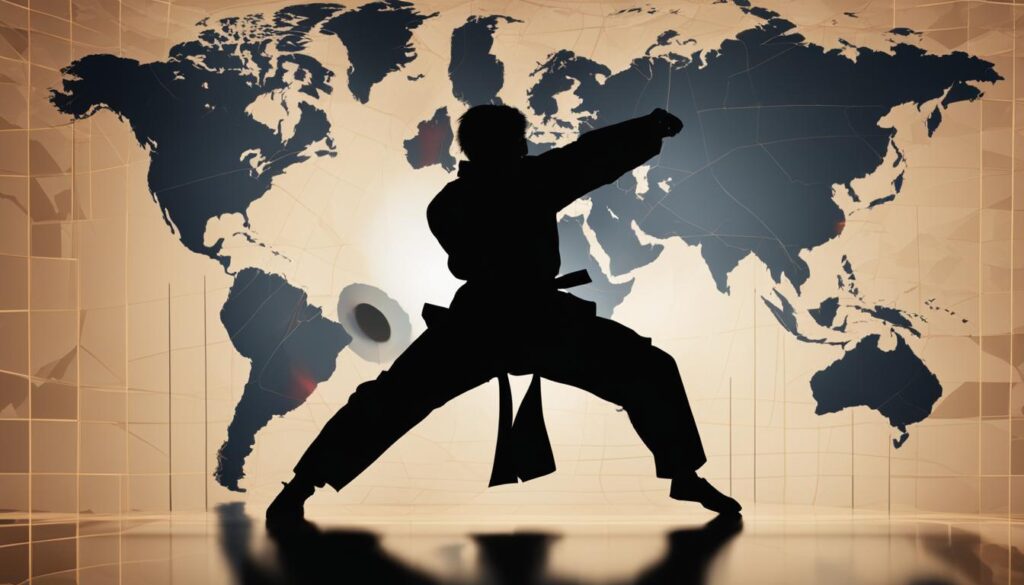
International Presence of Karate Organizations
| Organization | Year Established | Member Countries |
|---|---|---|
| World Karate Federation (WKF) | 1990 | 192 |
| International Karate Organization (IKO) | 1955 | 123 |
| Japan Karate Federation (JKF) | 1949 | 92 |
| European Karate Federation (EKF) | 1975 | 51 |
The international reach of karate is evident through the establishment of various karate organizations that span across numerous countries. The World Karate Federation (WKF), formed in 1990, currently boasts 192 member countries, underscoring the widespread practice and appeal of karate worldwide. Additionally, the International Karate Organization (IKO), founded in 1955, has 123 member countries, while the Japan Karate Federation (JKF) and the European Karate Federation (EKF) each have significant representation across 92 and 51 countries, respectively.
These organizations play a vital role in the promotion, development, and standardization of karate on a global scale. Through international tournaments, exchanges, and events, karate practitioners from different nations come together to celebrate, compete, and foster cultural exchange, further solidifying karate’s reputation as a martial art with widespread worldwide popularity.
The Philosophy and Discipline of Karate
Karate is not just a physical martial art but also a discipline that emphasizes mental attitude, rituals of courtesy, and a complex ranking system. The philosophy of karate revolves around self-improvement, self-discipline, and the cultivation of a nonviolent spirit. Karate practitioners, known as karate-ka, strive to develop not only their physical skills but also their character and mindset. Respect for one’s opponents, dedication to training, and adherence to the ethical principles of karate are central to the practice of this martial art.
Karate as a Sport and Competitive Activity
Karate has gained recognition as a competitive sport, with the inclusion of karate in the Olympic Games starting from 2021. Karate competitions typically involve both sparring, known as kumite, and performances of predetermined movements, known as kata. In sparring, participants aim to score points by landing clean strikes on their opponents, while kata showcases an individual’s mastery of a series of movements simulating defense and counterattack against imaginary opponents. Sporting karate emphasizes control, sportsmanship, and fair play, making it a thrilling and dynamic spectator sport.
| Type of Competition | Description |
|---|---|
| Kumite (Sparring) | In kumite, competitors engage in controlled combat, demonstrating their skill in delivering and evading strikes. Points are awarded for clean, effective techniques, such as punches, kicks, and strikes. |
| Kata (Form) | Kata involves the performance of a predefined sequence of movements, showcasing a practitioner’s technical skill, power, and precision. It is a solo demonstration of karate techniques and principles. |
Karate competitions bring together skilled athletes from around the world to test their abilities and compete for medals and accolades. The sport’s focus on discipline, control, and fair play ensures that athletes exhibit not only physical prowess but also respect and sportsmanship. The inclusion of karate in the Olympic Games reflects the sport’s growing global popularity and serves as a platform to showcase the talent and dedication of karateka on an international stage.
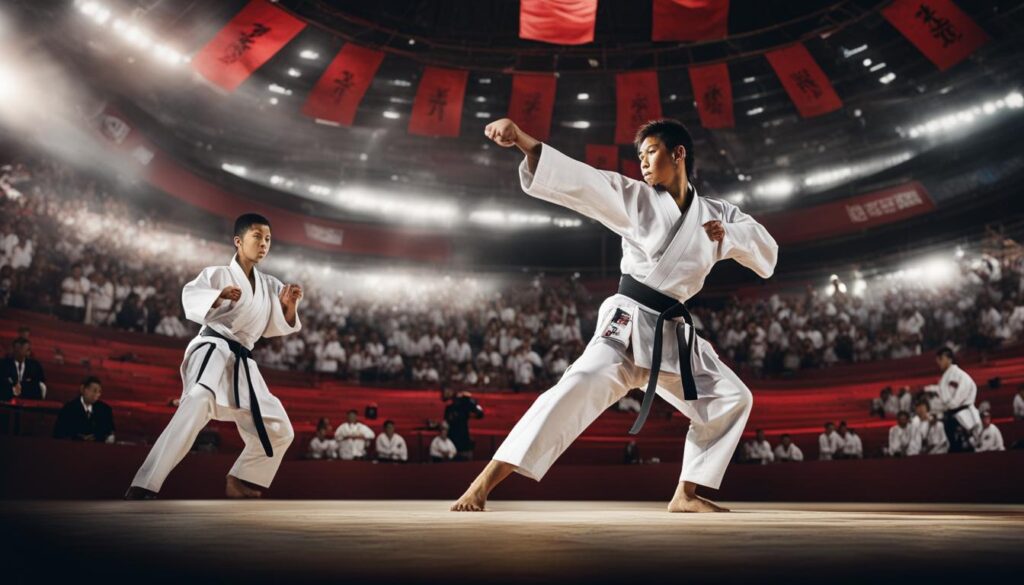
The Significance of Belts and Ranking in Karate
Karate employs a comprehensive ranking system that utilizes different colored belts to symbolize a practitioner’s progress and skill level. This system serves as a meaningful measure of achievement and recognition within the karate community.
As beginners, practitioners start with the white belt and progress through various colored belts, including yellow, orange, green, blue, brown, and ultimately black. Each belt represents a significant milestone in the practitioner’s journey, demonstrating their dedication, perseverance, and mastery of increasingly complex techniques and principles.
The ranking system fosters a sense of accomplishment and motivates practitioners to continually improve and refine their skills. It provides a tangible representation of their growth and development as karate practitioners.
Moreover, the belt system allows instructors and fellow practitioners to identify a person’s skill level and expertise. This differentiation is essential for organizing training sessions, arranging appropriate sparring partners, and ensuring a supportive and challenging learning environment.
The ranking system in karate is not solely based on technical proficiency but also considers other essential attributes such as character, discipline, and adherence to the principles of karate. It emphasizes the holistic development of the practitioner, both physically and mentally.
By earning higher belt ranks through consistent training, practitioners gain a sense of accomplishment, increased self-confidence, and self-discipline. They also learn the value of setting and achieving goals, overcoming obstacles, and embracing the core principles of karate.
In summary, the belt system in karate holds great significance. It serves as a visual representation of a practitioner’s progress, recognition of their skills, and a method for organizing the karate community. The journey through the different colored belts embodies the essence of karate’s ongoing pursuit of excellence and personal growth.
The Cultural Impact of Karate
Karate, with its rich history and traditions, has made a significant impact on popular culture around the world. Through its portrayal in movies, television shows, and other forms of media, karate has captivated audiences and influenced various aspects of society.
During the 1960s and 1970s, martial arts films featuring legendary actors like Bruce Lee and Jackie Chan brought karate into the mainstream. These movies showcased the physical prowess, discipline, and indomitable spirit associated with karate, sparking a global fascination with this ancient martial art.
“Karate has transcended its origins as a self-defense system and become a cultural phenomenon that resonates with people from all walks of life.”
Karate’s values of discipline, honor, and perseverance have permeated popular culture in many ways. Its influence can be seen in fashion trends, with the popularity of karate-inspired clothing and accessories. Karate’s impact extends to the music industry, with references to karate in song lyrics and the incorporation of martial arts-inspired choreography in music videos.
Furthermore, karate has influenced language and idioms. Phrases like “karate chop” and “black belt” have become part of everyday vocabulary, symbolizing strength, skill, and expertise. The cultural significance of karate is evident in the widespread recognition and understanding of these terms.
Table:
Movies Music Language Fist of Fury (1972) Kung Fu Fighting by Carl Douglas Karate Kid Enter the Dragon (1973) Everybody Was Kung Fu Fighting by CeeLo Green Karate chop Way of the Dragon (1972) Black belt
Karate’s cultural impact goes beyond entertainment and popular culture. It has also influenced the development of other martial arts, with karate techniques and principles being incorporated into various martial arts systems worldwide. This cross-cultural exchange has enriched the diversity and evolution of martial arts as a whole.
The cultural significance of karate continues to endure and resonate with people of all ages and backgrounds. As karate remains a source of inspiration and admiration, its impact on popular culture will continue to shape the way we perceive martial arts and embrace their values.
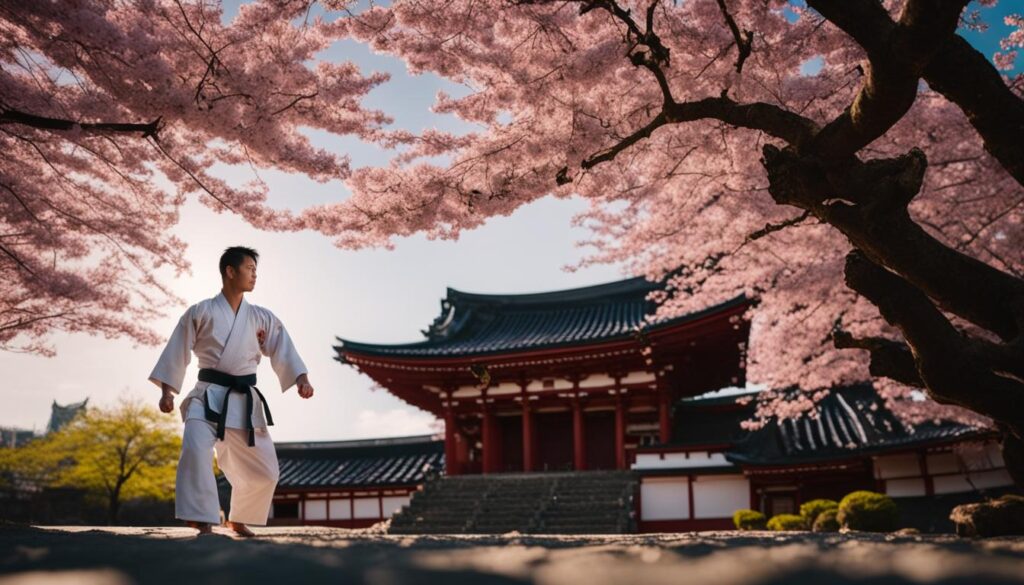
Traditional versus Modern Approaches to Karate
Karate, as a martial art, has evolved and adapted over time, giving rise to two distinct approaches – traditional karate and modern karate. While both approaches have their merits, they cater to practitioners with different goals and motivations.
The Essence of Traditional Karate
Traditional karate, rooted in the rich history and heritage of the art, places a strong emphasis on preserving and adhering to the original techniques, principles, and philosophies. It seeks to uphold the time-honored traditions and values associated with karate, such as self-defense, character development, and the exploration of the deeper meaning of martial arts.
In traditional karate, practitioners are encouraged to learn and understand the historical contexts in which techniques were developed. The focus is on mastering the fundamental movements and cultivating a strong foundation through rigorous training and discipline. Traditional karate seeks to develop not only physical skills but also mental fortitude and a nonviolent spirit.
One of the key aspects of traditional karate is the emphasis on kata, a predefined sequence of movements simulating defense and counterattack. Through kata practice, practitioners develop precision, fluidity, and the ability to apply techniques in a controlled manner.
The Integration of Modern Karate
Modern karate, while still maintaining respect for tradition, embraces elements of sport, competition, and physical fitness. It combines the core principles of karate with contemporary training methods and applications, making it accessible and appealing to a wider audience.
In modern karate, there is a greater emphasis on sparring, known as kumite, which enables practitioners to refine their techniques through practical application. The focus on competition enhances speed, agility, and strategic thinking, creating a dynamic and engaging experience for practitioners.
Additionally, modern karate incorporates various training and conditioning methods to improve physical fitness and overall performance. It recognizes the role of strength, endurance, and flexibility in maximizing one’s potential in karate.
The Synergy of Traditional and Modern
While traditional and modern approaches to karate may seem distinct, they are not mutually exclusive. Many modern karate styles and systems still maintain a strong foundation in traditional karate principles. Likewise, practitioners of traditional karate often integrate aspects of modern training methods and applications.
The synergy between traditional and modern approaches allows practitioners to benefit from the best of both worlds. They can honor the historical legacy of karate while embracing the evolving nature of the martial art in contemporary times.
Ultimately, whether one chooses to pursue traditional karate or modern karate depends on their personal preferences, goals, and motivations. Both approaches offer unique opportunities for growth, self-discovery, and the pursuit of excellence in the art of karate.
Karate as a Path to Personal Growth
Beyond its physical and competitive aspects, karate offers numerous benefits for personal growth and development. Regular practice of karate improves physical fitness, coordination, and flexibility. It instills discipline, self-confidence, and self-control. Karate also fosters mental resilience, focus, and stress management. Through the challenges and achievements in training, practitioners learn valuable life lessons such as perseverance, goal setting, and teamwork. The holistic nature of karate training promotes overall well-being and personal growth in various aspects of life.
The Role of Karate in Self-Defense
One of the fundamental purposes of karate is self-defense. The techniques and principles taught in karate provide practitioners with the skills and confidence to defend themselves in real-life situations. Karate emphasizes effective striking, blocking, and evasive maneuvers to neutralize threats and protect oneself. By developing physical fitness, awareness, and the ability to remain calm under pressure, practitioners are better equipped to handle potentially dangerous situations. However, it is important to note that karate advocates for nonviolent resolution whenever possible and encourages practitioners to avoid physical confrontations whenever possible.
Self-defense is a crucial aspect of karate, ensuring that individuals can protect themselves and others in the face of danger. The practical applications of karate techniques equip practitioners with the tools needed to defend against various attacks, including strikes, grabs, and holds. Through rigorous training and practice, karate students learn how to respond swiftly and effectively to threats, deterring potential attackers and diffusing volatile situations.
The use of strikes, kicks, and blocks in karate enables practitioners to quickly incapacitate an assailant. These techniques are designed to target the vulnerable areas of an attacker’s body, such as the groin, eyes, throat, and joints. By targeting these areas with precision and force, karate practitioners can disable or immobilize an attacker, giving themselves time to escape or seek help.
Besides physical techniques, karate also emphasizes mental preparedness and situational awareness. Training in karate cultivates a heightened sense of awareness, allowing practitioners to recognize potential threats and assess dangerous situations. By staying calm and level-headed, karate practitioners can respond appropriately and decisively, using the techniques and strategies they have learned to protect themselves and others.
It’s important to note that karate and self-defense extend beyond physical techniques. Karate teaches practitioners to develop self-confidence, discipline, and self-control. These qualities not only contribute to their ability to handle dangerous situations effectively but also help them avoid conflicts by diffusing tense scenarios peacefully. The practice of karate fosters a mindset of nonviolence and encourages practitioners to seek non-physical solutions whenever possible.
Benefits of Karate for Self-Defense
Practicing karate for self-defense offers several benefits, including:
- Self-confidence: Karate builds self-confidence by teaching practitioners essential skills and empowering them to handle potentially threatening situations.
- Physical fitness: Regular karate practice improves strength, stamina, and agility, enhancing overall fitness levels and ensuring practitioners have the physical capabilities to protect themselves.
- Self-control: Karate instills discipline and self-control, enabling practitioners to make sound decisions and respond appropriately in high-pressure situations.
- Situational awareness: Karate training hones situational awareness, allowing practitioners to assess potential threats and respond proactively.
- Conflict resolution: Karate promotes nonviolent resolutions and encourages practitioners to avoid physical confrontations whenever possible.
By developing these skills and qualities, individuals who practice karate for self-defense gain the tools they need to protect themselves and others effectively. This comprehensive approach to self-defense makes karate a valuable martial art for practical use in real-world scenarios.
Navigating Self-Defense Situations with Karate
“In karate, there is no first strike.”
– Gichin Funakoshi
Karate’s emphasis on nonviolence and self-control is vital in self-defense situations. While karate equips practitioners with the skills to neutralize threats, the ultimate goal is to diffuse conflicts and protect oneself without causing unnecessary harm.
When confronted with a potential threat, karate practitioners should prioritize their personal safety and the safety of others. Here are some key guidelines to follow:
- Stay calm and assess the situation: Maintain composure and evaluate the threat’s level and intent to determine the appropriate course of action.
- Use verbal and non-physical techniques: Attempt to de-escalate the situation through clear communication, assertiveness, and confidence, if possible.
- Focus on escape and evasion: If physical confrontation is unavoidable, use karate techniques to create an opportunity to escape and seek help.
- Only use necessary force: Apply techniques with caution and restraint, aiming to immobilize the attacker without causing excessive harm.
- Seek immediate assistance: Once the situation is under control or the attacker has been neutralized, call for help or seek aid from authorities.
Remember, self-defense with karate is about safeguarding oneself and others rather than seeking confrontation. It is crucial to use karate techniques responsibly and apply the principles of nonviolence to resolve conflicts whenever possible.
Real-Life Applications of Karate in Self-Defense
Karate’s practical applications in self-defense extend to various real-life situations, including:
- Street altercations: Karate equips practitioners with the necessary tools to protect themselves in confrontations on the street, such as muggings or assaults.
- Home invasions: In the event of a break-in, karate techniques can be utilized to defend oneself and loved ones from intruders.
- Harassment or bullying: The skills learned in karate can help individuals effectively respond to harassment and bullying situations, ensuring personal safety and well-being.
- Conflict resolution: Karate techniques and mental discipline enable practitioners to diffuse conflicts and protect themselves without resorting to violence.
While karate can be a powerful tool for self-defense, it is essential to remember that every situation is unique, and personal safety should always be the top priority. Avoid confrontations whenever possible and seek peaceful resolutions before resorting to physical techniques.
| Benefits of Karate for Self-Defense | Guidelines for Self-Defense with Karate | Real-Life Applications of Karate in Self-Defense |
|---|---|---|
| Improves self-confidence | Stay calm and assess the situation | Street altercations |
| Enhances physical fitness | Use verbal and non-physical techniques | Home invasions |
| Develops self-control | Focus on escape and evasion | Harassment or bullying |
| Hones situational awareness | Only use necessary force | Conflict resolution |
Karate’s Influence on Other Martial Arts
Karate has had a profound impact on various martial arts, both within Japan and globally. Through the exchange of knowledge and techniques, karate has played a pivotal role in the development of hybrid styles and innovative approaches to combat. With its emphasis on striking, blocking, and agility, karate has influenced other striking-based martial arts such as taekwondo and kickboxing.
One of the key reasons for karate’s influence on other martial arts is its strong cross-cultural connections. Cultural exchanges and the global popularity of karate have led to the incorporation of karate techniques and principles into other martial arts systems, enhancing the diversity and evolution of martial arts as a whole.
In addition to technique exchange, karate has also contributed to the development of new training methods and philosophies. Its focus on discipline, respect, and self-improvement has inspired similar values in other martial arts.
Overall, karate’s influence on other martial arts has been instrumental in shaping the landscape of combat disciplines. By fostering cross-cultural influences and encouraging innovation, karate continues to leave a lasting impact on the world of martial arts.
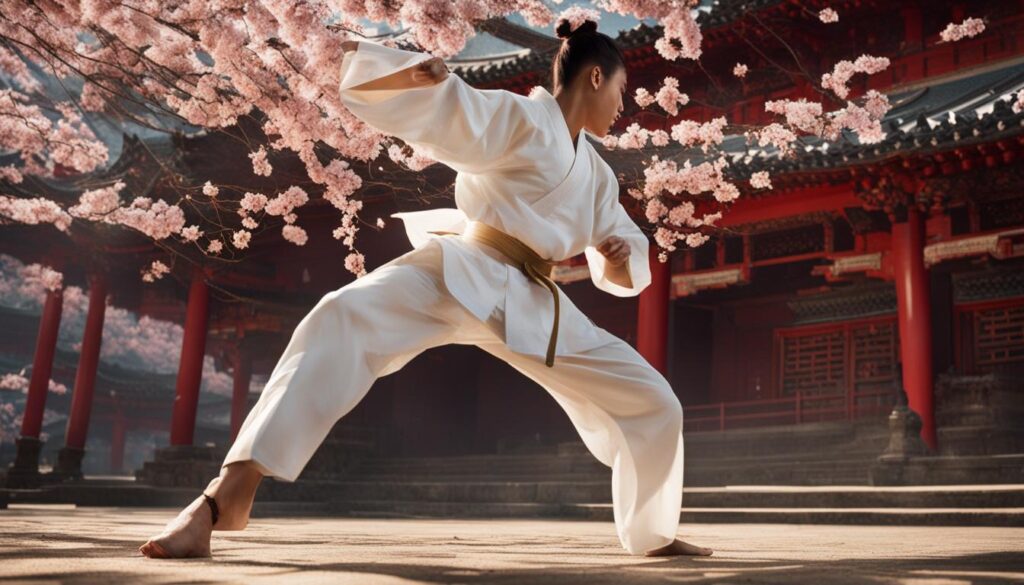
Karate practitioners have influenced and enriched various martial arts around the world.
The Future of Karate
Karate, as a martial art, continues to evolve and adapt to the changing times. With its growing recognition and popularity as a global sport, the inclusion of karate in the Olympic Games showcases its potential for an exciting future. Advances in technology, innovative training methods, and cultural exchange will undoubtedly shape the evolution of karate moving forward.
As new generations of practitioners emerge, they bring fresh perspectives and ideas that push the boundaries of what karate can be. These innovators will build upon the foundation of traditional karate while introducing modern elements that make the art more accessible and engaging.
Furthermore, the increasing global connectivity and exchange of knowledge will contribute to the continued evolution of karate. Different styles and techniques from various regions will fuse together, creating a melting pot of diverse influences that enrich the practice of karate.
Throughout its future development, karate will remain grounded in its core principles and values. The discipline, respect, and self-improvement that define karate will remain at the heart of the art, ensuring its continuity and integrity.

| Advancements | Innovative Training Methods | Cultural Exchange |
|---|---|---|
| Technological advancements will revolutionize training techniques and equipment, enhancing the effectiveness and efficiency of karate practice. | New and creative training methods will emerge, incorporating elements from other disciplines like sports science and psychology, leading to improved performance and injury prevention. | Cultural exchange will expose karate practitioners to different perspectives and approaches, allowing for the integration of diverse influences and the continuous growth of the art. |
The future of karate holds exciting possibilities for continued growth and exploration. As practitioners embrace innovation while staying true to the art’s roots, karate will continue to captivate and inspire individuals worldwide.
Conclusion
Karate, with its roots in Okinawa and influences from Chinese martial arts, has a rich and fascinating history. It started as a means of self-defense on the island of Okinawa in the 17th century and eventually spread to mainland Japan, thanks to the efforts of Master Gichin Funakoshi. Funakoshi’s synthesis of different Okinawan styles into the Shotokan system played a crucial role in popularizing karate in Japan and beyond.
Today, karate is practiced by millions of people worldwide and has gained recognition as a competitive sport. Its dynamic techniques and philosophical principles have shaped popular culture, permeating films, television shows, and other forms of media. But karate is more than just physical movements; it is a discipline that promotes personal growth, self-discipline, and the cultivation of a nonviolent spirit.
As karate continues to evolve and adapt, the future holds exciting possibilities. With its blend of tradition and modernity, karate will remain a source of inspiration for practitioners around the world. Its rich history, combined with its global reach and enduring values, ensures that karate will continue to thrive and leave a lasting impact on the martial arts landscape.
FAQ
Where did karate originate?
Karate originated in Okinawa, an island in Japan, in the 17th century.
What is the meaning of karate?
Karate means “empty hand” in Japanese.
How did karate evolve?
Karate evolved from the blending of local fighting techniques in Okinawa and Chinese martial arts influences.
Who introduced karate to mainland Japan?
Master Gichin Funakoshi introduced karate to mainland Japan and synthesized different Okinawan styles into the Shotokan system.
Is karate popular worldwide?
Yes, karate is practiced worldwide and has become one of the most popular martial arts with over 100 million practitioners globally.
What are the philosophical principles of karate?
The philosophy of karate revolves around self-improvement, self-discipline, and the cultivation of a nonviolent spirit.
Is karate a competitive sport?
Yes, karate is recognized as a competitive sport, and it will be included in the Olympic Games starting in 2021.
What is the significance of belts and ranking in karate?
The belt system in karate serves as a measure of a practitioner’s progress and skill level, with higher belt ranks indicating increasing expertise.
How has karate influenced popular culture?
Karate’s values of discipline and perseverance have permeated various aspects of popular culture, influencing fashion, music, and language.
What are the benefits of practicing karate?
Regular practice of karate improves physical fitness, coordination, mental resilience, and fosters personal growth and discipline.
Can karate be used for self-defense?
Yes, karate techniques and principles provide practitioners with effective self-defense skills and the confidence to handle real-life situations.
Has karate influenced other martial arts?
Yes, karate has had a significant influence on other martial arts, leading to the development of hybrid styles and the incorporation of karate techniques and principles.
What does the future hold for karate?
The future of karate is promising, with its inclusion in the Olympic Games and continued growth, adaptation, and preservation of its rich history.
